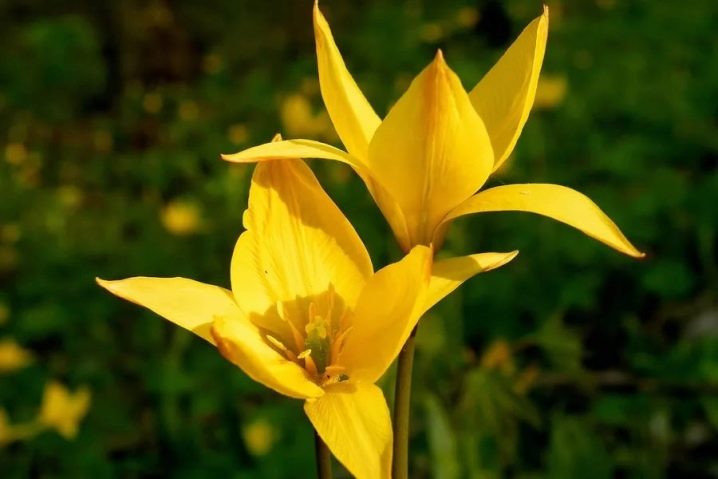Tulip Bieberstein: description of the species, planting and care rules

Tulips are beautiful and at the same time unpretentious spring plants. Most of the varieties are perennials, which not only professional flower growers prefer to plant, but also just amateurs. One of the most interesting species of such plants is the Bieberstein tulip, which grows in the wild. Next, we will take a closer look at the Bieberstein tulips, find out their description, the nuances of planting and growing.


What it is?
The Bieberstein tulip, like many others from the Liliaceae family, is a perennial bulbous plant. Very unpretentious in cultivation and home care. It is known for the fact that it grows without much difficulty in the wild, belongs to the steppe varieties.
Distributed in many countries abroad. The stem of a tulip is naked and straight, reaches a height of 15-40 cm.The leaves are bright green. The flowers have a rich yellow color, they are solitary, in shape they resemble bright stars. In diameter, they reach no more than 5 cm, more often - 3. The length of the leaves themselves is about 3 centimeters, there are 6 of them in total.

The plant blooms in warm weather already in April, but most often in May. This plant propagates mainly with the help of seeds, since its bulbs are considered to be poisonous. Although the bulbous method is quite common.
This plant is also known for its pleasant scent. It is very light-loving, and therefore it blooms long before the trees that create shade begin to turn green in the spring.
This steppe tulip independently scatters ripe seeds, which easily take root in a variety of areas. That is why it is so often possible to observe whole meadows with yellow flowers.


Growing
If you have a desire to grow a wild tulip in your garden, it is worth paying attention to some important points of this process.
- First, you need to find a good landing site. It should be open, spacious, light and semi-shaded. Too shaded places are not recommended, and the plant will quickly wither under the scorching rays of the sun. It is also very important to plant any varieties of tulips away from groundwater, which tend to wash away the root system of plants, as a result of which they begin to rot.
- It is best to give preference to loamy and fertile soil when planting tulips. Ideal would be a neutral soil composition that you can fertilize yourself.
- Tulips are planted in spring or autumn. The second option is more preferable and favorable.
- The wells for the onions should be made small, but at a certain interval from each other. A little sand can be poured on their bottom to reduce the likelihood that the roots will rot in the future.
- When the bulbs are planted in the fall, most of the bulbs will form the root system before winter begins. At the first frost, it is advised to cover the beds with tulips. For this, peat or humus can be used.


It is recommended to dig up tulips for the winter, and this should not be done at the end of summer, but almost always after flowering. Tulips, the bulbs of which have been in the ground all summer, usually become smaller in the following flowering years. That is, the flower will become even more miniature. Dug up bulbs are usually disinfected, dried and put into boxes for the winter.

Care
In order for the plant to grow healthy and bloom in due time, it should be properly looked after. Usually, complex fertilizing is done no more than 3 times per season. The first feeding is carried out before the emergence of tulips, the next - at the stage of bud ripening and, finally, during the flowering itself. Dry formulations of fertilizers can be used even when there is still residual snow on the ground, but fertilizers in a composition with potassium and phosphorus are recommended for the flowering period. Complex fertilizing can be applied while watering plants.
In general, caring for Bieberstein tulips is minimal. The main thing is to water the plants on time, but in moderation, and in no case overflow them. After watering, it is recommended to loosen the soil, which is very beneficial for perennial tulips. It is also important to remove weeds and grass that grow near the tulips. Weeds not only pollute the area, but they also draw nutrients from tulips, which makes them sick and does not even bloom.
If there is a desire to collect seeds, then the faded flowers should be immediately removed to give the plant strength for further maturation of the seeds.


As for the prevention of insect attacks and the appearance of any diseases, it should be noted that you can use both chemical and folk remedies. For spraying, herbal tinctures of chamomile, dandelion and wood ash are often used, and a solution based on laundry soap is used as a home insecticide. Of course, such remedies may not completely get rid of annoying beetles or ants. That's why when attacking whiteflies or aphids, it is best to use ready-made preparations.
You should work with them only according to the instructions, and also do not forget about personal safety precautions.
Bieberstein tulips look great in a variety of flower beds and alpine slides, they add a touch of brightness to them among other flowers. With very simple care, proper feeding and regular watering, the plants will annually delight with their flowering in the earliest spring.



For more information on the Bieberstein tulip, see the next video.







































































































The comment was sent successfully.